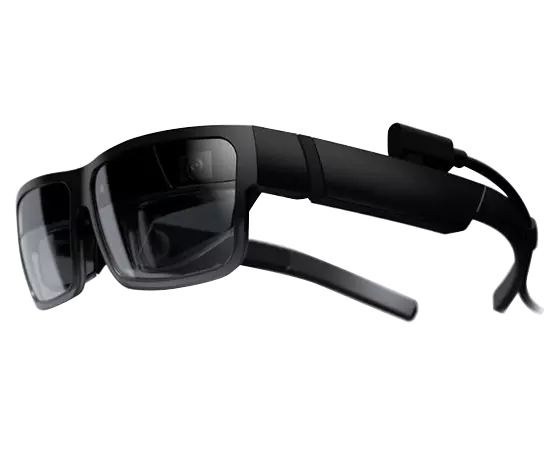Lenovo’s Enterprise-Focused Augmented Reality Glasses
Ready to learn all about the Lenovo ThinkReality A3 glasses?
The Lenovo ThinkReality VRX headset delivers a comfortable, intuitive, and powerful virtual reality experience, with full-color passthrough and 6 degrees of freedom. However, this isn’t the first solution introduced in the ThinkReality range.
For years, Lenovo has positioned itself as a leader in the enterprise technology space, producing laptops, computers, peripherals, and accessories that empower modern teams. Lately, the company has increased its focus on the evolving landscapes of extended reality and artificial intelligence.
The Lenovo ThinkReality A3 glasses emerged as one of the first enterprise-grade sets of smart glasses designed to enhance work and collaboration on a massive scale. As Lenovo continues to build out its XR portfolio, I thought it was about time I took a closer look at these smart specs.

What are the Lenovo ThinkReality A3 Glasses?
The Lenovo ThinkReality A3 glasses are a set of augmented reality specs, which connect to your laptop or computer, offering users the opportunity to create a customizable, immersive workplace wherever they are. Originally announced by Lenovo in December 2021, these glasses were some of the first to show enterprise users just how powerful AR could be in the workplace.
Secure and customizable, the glasses are designed to fit a user’s head perfectly and support 6 degrees of freedom, as well as dual 1080p AR displays. Here’s a quick rundown of the specs.
- Lightweight design (less than 130g)
- 8MP camera
- Dual 1080p AR displays
- Qualcomm XR-1 Smartviewer chip
- 3 Integrated microphones
- Integrated speakers
- IP54 rating
- Dual fish-eye cameras for 6DoF tracking
- USB Type C, and USB 3.1 connectivity
- Voice, object and image recognition
- Head/gaze tracking
- Integrated barcode reader
Design and Comfort
Plus, there are a range of interchangeable front covers available, from tinted cosmetic lenses to safety shields intended for industrial settings. One thing I appreciate about these glasses is that they support prescription lenses, which can mount to the nosepiece, meaning you don’t have to try and fit your own standard specs behind the AR lenses.
Compared to some of the other smart glasses I’ve reviewed, the Lenovo ThinkReality A3 glasses are a little clunkier, but they’re still far more lightweight and ergonomic than most MR headsets. Lenovo has designed these specs to be as comfortable as possible. They come with an ergonomic kit, allowing you to change the nosepiece and ear horn extensions to suit your needs.
Plus, for those working with sensitive data, you can rest assured that the glasses will only show information to you, minimizing the risk of data leaks.
Another key point worth noting is that Lenovo has considered the specific needs of industrial workers with these glasses. For instance, the ThinkReality A3 safety lenses are impact-resistant and come with side shields to help protect your eyes against dust and debris.
On a broad scale, the glasses feature all of the key components you would expect from a set of AR specs, including integrated speakers (and 3 microphones for collaboration) and volume control buttons. Developers can even customize the experience with extra features for object, voice, and image recognition through Lenovo’s software.

The Functionality: What Can the Specs Do?
The Lenovo ThinkReality A3 glasses were originally designed for use with compatible Lenovo laptops and computer systems. Now, however, users can also connect their specs to a Motorola Edge+ device to access extra features like 5G speeds and Wi-Fi 6 connectivity.
The specs work with the Holo One sphere suite of products, giving users a range of certified solutions and turnkey applications to experiment with. You can access remote assistant tools for immersive collaboration, 3D digital collaboration features, and guided workflow support.
Companies can even create immersive learning experiences for team members and customers thanks to the software support from Sphere. Notably, there aren’t as many out-of-the-box applications available for the Lenovo ThinkReality A3 as you’d get from some other vendors.
Fundamentally, these glasses are designed to essentially “replace” your laptop screen, giving you a virtual, private monitor you can interact with in any environment. You can connect the glasses to your PC or smartphone via a USB cable and immediately launch a huge virtual desktop or even view multiple virtual monitors simultaneously.
However, I found the glasses extremely useful for all kinds of work. These specs could be particularly handy if you’re working with sensitive data and spreadsheets that you don’t want other people to see over your shoulder when you’re in a less secure setting (like a coffee shop).

The Overall Experience
Like most smart glasses I’ve tried in the past, Lenovo’s ThinkReality A3 has pros and cons. One thing I really liked about these glasses is the gaze-based navigation system, which makes it easier to sort through and manage content on virtual desktops.
I didn’t encounter many issues with the software, however, and it’s worth noting that many other AR glasses struggle with similar bugs. When looking up reviews from other testers, I noticed a common complaint was that these glasses don’t come with access to many apps and games.
While that is true to a certain extent, it’s worth remembering that Lenovo designed these glasses specifically for enterprise users. They’re not targeted towards everyday people who just want to experiment with AR glasses. These are specs specifically intended to boost workplace productivity, efficiency and creativity – and in that regard, they do very well.
The menu system is also extremely intuitive, although you may need to occasionally re-center your virtual monitors. Additionally, the software experiences can be a little clunky in places. You may find that your apps occasionally crash, forcing you to shut everything down and start your system up again – which isn’t ideal in the middle of an intense workflow.
One thing I will note is that the Field of View (FOV) is a little limited with these glasses, but I’ve noticed a similar issue with many of the specs I’ve tested in the past. You still get a very immersive and engaging experience overall, but the virtual monitors won’t cover your entire field of sight.

The Lenovo ThinkReality A3 Smart Glasses: The Verdict
If nothing else, these glasses demonstrate just how much time and effort Lenovo has put into creating unique, immersive experiences for companies interested in the enterprise metaverse. If the company continues to surge ahead in with the development of new XR products going forward, we might even see an updated version of their specs arriving in the years to come.
So, are the Lenovo ThinkReality A3 smart glasses worthwhile? There are certainly more advanced AR/VR and mixed reality solutions out there. However, I still think Lenovo’s specs are one of the best options for enterprise users. Unlike most alternatives, they’re robust, reliable, comfortable, and designed specifically to address the needs of business users.
In the meantime, if you’re looking for AR glasses that enhance workplace security, protect your eyes, and deliver an intuitive experience, the ThinkReality A3 specs are still a good choice. I’d recommend giving them a try if you get the opportunity.
Read More-I spent an hour in the Virtuix Omni One full-body VR rig — here’s what it feels like

























